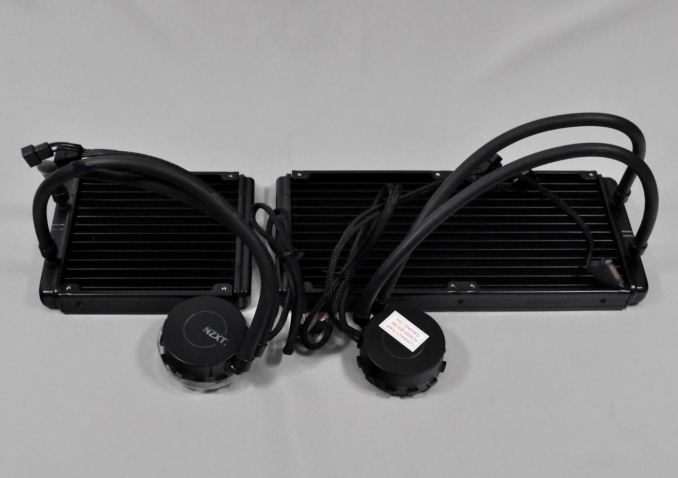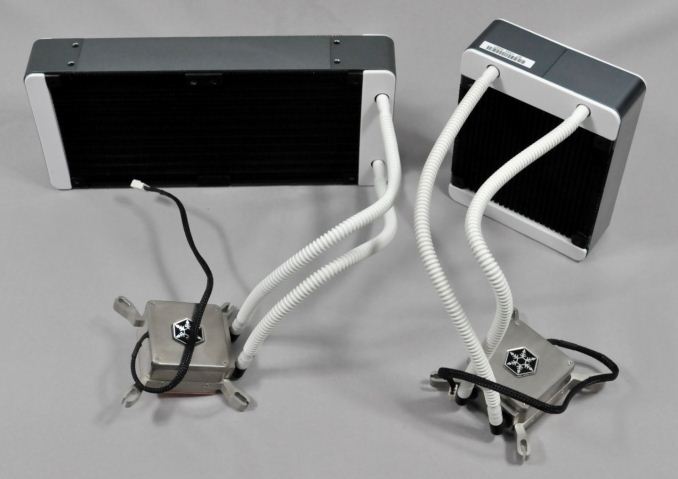Closed Loop AIO Liquid Coolers: 14-way Mega Roundup Review
by E. Fylladitakis on February 12, 2014 7:00 AM ESTEnermax
The two AIO coolers from Enermax that we had the chance to look at share a similarly sized, 120mm x 120mm radiator, yet they are absolutely nothing alike. The Liqmax 120S is a product designed with value in mind, to compete with AIO coolers in the league of the Cooler Master Seidon 120V and the Corsair H75. Its thermal performance is unimpressive, slightly worse than that of the Seidon 120V, yet the noise levels of the Liqmax 120S are considerably lower. It is unable to compete with the dual-fan H75 though, at least not while maintaining similar noise levels.
The Liqtech 120X on the other hand is very impressive, especially in terms of quality and aesthetics. A simple inspection reveals that the radiator and block of the Liqtech 120X are much better made than those of most other kits. It delivers good thermal performance while maintaining very low noise levels, considering the size of its radiator and the use of 120mm fans. The downside is that the Liqtech 120X owes much of its good performance on the extra-thick radiator, which could lead to compatibility problems with some cases if there is not enough clearance.
The only great problem that all AIO coolers from Enermax have is the low availability, as they currently are not available in North America at all and few retailers stock them in Europe. They can be imported to the US from Asia or Europe but that is a financially unrealistic option.
NZXT
NZXT currently offers only two high performance AIO coolers, both with 140mm wide radiators, which limits their compatibility significantly. On the other hand, they are the only coolers with extended (≈ 40cm) tubing, allowing the radiator to reach the front panel of a tower case. Still, the number of cases currently capable of supporting a 140mm wide radiator is quite limited.
Both the Kraken X40 and the Kraken X60 performed well in our tests, offering thermal performance similar to other AIO coolers of the same class. Specifically, they offer lower thermal performance than Cooler Master's 140mm wide coolers but maintain reasonable noise levels, while they display about the same thermal performance as Corsair's offerings but are not as quiet. While better fans could have been selected, NZXT has a tremendous advantage over the competition; the Kraken X40 and Kraken X60 retail for about the same price as other 140mm wide AIO coolers but only NZXT's offerings feature a USB interface. The USB interface allows the user to monitor and fine-tune the performance/noise ratio of the cooling system directly from the desktop, as well as to program custom LED lighting colors and effects.
Silverstone
Silverstone currently offers only two AIO liquid coolers, the Tundra TD02 and the Tundra TD03, both of which we have tested in this review. They are both based on the same design, with their only difference being the size of the radiator. Although the design of the Tundra TD03 is similar to that of the Enermax Liqtech 120X, the aesthetic design of Silverstone's offerings is quite different, going with a white/grey/nickel color theme instead of Enermax's black/red. The OEM behind them might be the same, although that is a mere guess on our part, as the fin design and frame of the radiators are significantly different.
The appearance, feel and quality of the Tundra TD02 and Tundra 03 are outstanding, greatly superior to that of most other kits. On the other hand, the overall performance of these kits actually disappointed us. It is by no means bad, as both of Silverstone's AIO coolers deliver thermal performance comparable to that of other similarly sized kits at reasonable noise levels and are especially efficient under low fan speeds. However, we expected a lot more from kits with radiators this thick and with such a classy appearance.
The mediocre performance may be due to the narrow corrugated tubing, a weak pump, a wrong choice of fans, or any combination of the above, but the fact is that a performance upgrade is required in order to overtake the competition. Furthermore, we are unsure about the white/grey color theme, as it will most likely stand out way too much inside all-black cases and that is not always the desired effect. Still, the balance between quality, performance, and value is very good and Silverstone's AIO coolers will become a favorite among those who want to combine low-noise operation and good looks. Just make sure that the 45mm thick radiators will fit inside your system before purchasing one!













139 Comments
View All Comments
lwatcdr - Thursday, February 13, 2014 - link
And maybe the CoolerMaster Evo 212Streetwind - Wednesday, February 12, 2014 - link
Excuse me for pointing this out, but are the noise levels given here not a little bit bogus? On your "Testing Methology" page, you qualify 50-54 dB(A) as "Extremely loud (level equivalent to a ≈1500W vacuum cleaner)". Then on the next page in your 12V results, you state: "To give you a rough estimate, 56 dB(A) represents about the same level of sound as a typical box fan the same distance."Are you honestly trying to imply that a CPU fan is capable of producing a typical noise scenario that is twice as intense as a 1500W vacuum cleaner at full bore? I think that either the table under "Testing Methodology" is wrong, or you performed your tests in a way that generates results which have absolutely nothing whatsoever to do with the scale presented in the table. In both cases, said table is in dire need of a revision.
The article is very nice and no doubt took a lot of work, but with the noise levels looking as arbitrary as they do, it's very difficult to glean much value from it other than a rough order of absolute cooling performance. There's no noise floor given either, and no qualifying comparison to an air cooling solution.
E.Fyll - Wednesday, February 12, 2014 - link
That is my error. The original sentence was something along the lines of "To give you a rough estimate, 56 dB(A) represents about the same level of sound as a small vacuum cleaner over the same distance". I was then told that vacuum cleaners in the US are generally larger and much louder than their counterparts here and that the comment was edited, but I foolishly did not check the article. 56dB(A) is definitely loud, as much as two of the loudest 140 mm fans, although not as loud as a vacuum cleaner; at least not the kind of vacuum cleaners most readers here are used to. :) More like to the noise of a small hair dryer, I suppose.LancerVI - Wednesday, February 12, 2014 - link
Thanks for the explanation. When I heard "as loud as a vacuum cleaner" I was taken aback. Our vacuums are LOUD! My custom WC loop is loud, but it's no where near vacuum cleaner loud.Impulses - Thursday, February 13, 2014 - link
Now I'm intrigued by these stealthy Euro vacuum cleaners... :p3DoubleD - Thursday, February 13, 2014 - link
Me too... please review!svandamme - Tuesday, December 2, 2014 - link
take it from me , they suckConnoisseur - Wednesday, February 12, 2014 - link
It would be great to see a quiet system builder's guide with different components and form factors. My holy grail has always been a mid-upper range miniITX gaming system that's virtually silent 90% of the time. Something with a core i5 or i7 CPU and R9 270x or GTX 760 stuffed into a small case with quiet operation. Probably doesn't exist yet but one can always hope :)w1z4rd - Monday, February 17, 2014 - link
I'm running a 4770k on an Asus Maximus VI Impact with a Corsair h100i and an EVGA GTX770 in a Corsair 250D that's sitting on my desktop. Unless I'm gaming I can't hear the thing. I don't hear it when gaming either, actually, as I have a headset on.Navvie - Wednesday, February 12, 2014 - link
Ever think about asking Mike Chin at SPCR to do some noise testing for you?